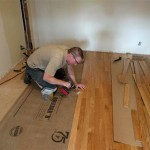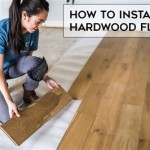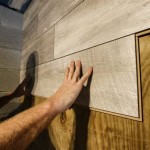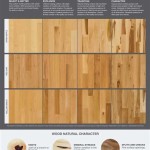Laminate Flooring Over Particle Board: Considerations and Best Practices
Laminate flooring, a popular choice for homeowners due to its durability, aesthetic versatility, and affordability, is frequently installed over various subfloors. One common existing subfloor is particle board. While installing laminate flooring directly over particle board can be done, it's crucial to understand the potential challenges and necessary precautions to ensure a successful and long-lasting installation. This article will explore the key considerations, best practices, and potential pitfalls associated with laying laminate flooring over a particle board subfloor.
Assessing the Condition of the Particle Board
The primary determinant of whether or not laminate can be successfully installed over particle board hinges on the condition of the existing subfloor. Particle board, composed of compressed wood chips and resin, is susceptible to moisture damage and can deteriorate rapidly if exposed to humidity or water. Before even considering installation, a thorough inspection is paramount.
The first step is a visual inspection. Examine the particle board surface for any signs of water stains, discoloration, or swelling. These are telltale signs of moisture exposure. Pay close attention to areas near plumbing fixtures, exterior walls, and doorways, as these are common entry points for moisture. If any discoloration is present, the extent of the damage must be determined.
Following the visual inspection, a physical assessment is necessary. This involves probing the particle board in suspected problem areas with a screwdriver or awl. The tool should be able to penetrate the particle board with minimal resistance. If the board feels soft, crumbles easily, or exhibits visible signs of decay, it's compromised and unsuitable for laminate installation. Repairing or replacing the affected sections is essential before proceeding.
Furthermore, check the particle board for flatness and levelness. Laminate flooring requires a relatively smooth and even surface to prevent flexing and potential damage to the locking mechanisms. Use a long straightedge and a level to identify any significant dips, humps, or unevenness in the subfloor. Minor imperfections can sometimes be addressed with leveling compounds, but larger discrepancies may require more extensive repairs or even subfloor replacement.
Finally, ensure the particle board is securely fastened to the underlying joists. Loose or squeaky subflooring can transfer movement to the laminate, leading to creaking and premature wear. Drive screws into the particle board at regular intervals to secure it firmly to the joists below. If the particle board is severely damaged or extensively loose, replacing the entire subfloor might be the most effective and durable solution.
Preparing the Particle Board Subfloor
Assuming the particle board is deemed suitable for laminate installation, adequate preparation is necessary to ensure a successful outcome. Proper preparation minimizes the risk of future problems and prolongs the life of the laminate flooring.
The first step is cleaning the subfloor thoroughly. Remove any debris, dust, dirt, and remnants of old flooring materials. A shop vacuum is ideal for this task. Ensure that the surface is completely clean and free of any contaminants that could interfere with the underlayment or laminate installation.
Once cleaned, address any minor imperfections in the particle board. Small holes or cracks can be filled with wood filler or patching compound specifically designed for wood or particle board. Allow the filler to dry completely according to the manufacturer's instructions and then sand it smooth to blend seamlessly with the surrounding surface.
Addressing unevenness is a critical step. If the particle board has minor dips or variations, a self-leveling compound can be used to create a smooth and even surface. Follow the manufacturer's instructions carefully when applying the compound. Proper preparation of the surface before applying self-leveling compound is crucial for optimal adhesion.
After addressing imperfections and leveling, consider applying a moisture barrier or sealant to the particle board. This is especially important in areas prone to humidity or moisture. A moisture barrier will help prevent moisture from seeping into the particle board from below, which can cause swelling, warping, and ultimately damage the laminate flooring. Choose a sealant specifically designed for wood or particle board and apply it according to the manufacturer's recommendations.
Finally, consider sanding the surface of the particle board lightly to create a better bonding surface for the underlayment. This helps the underlayment adhere more effectively and prevents it from shifting or moving under the laminate flooring. Avoid sanding excessively, as this could damage the particle board surface. A light sanding is sufficient to create a slightly rough texture for better adhesion.
The Importance of Underlayment
Underlayment plays a crucial role in any laminate flooring installation, but it's particularly important when installing over particle board. The underlayment provides several benefits, including cushioning, noise reduction, and moisture protection. Selecting the appropriate underlayment is essential for maximizing the performance and longevity of the laminate flooring.
One of the primary functions of underlayment is to provide cushioning. It helps to absorb impact and reduce the stress on the laminate flooring, preventing cracks and damage. This is especially important over particle board, which can be less resilient than other subfloor materials. Choose an underlayment with adequate thickness and density to provide sufficient cushioning.
Noise reduction is another significant benefit of underlayment. It helps to dampen sound transmission, reducing the echoing and footstep noise that can be common with laminate flooring. This is particularly important in multi-story homes or apartments where noise transmission can be a concern. Look for underlayments with specific noise reduction ratings (STC and IIC) to compare their performance.
Moisture protection is perhaps the most critical function of underlayment when installing over particle board. As previously mentioned, particle board is highly susceptible to moisture damage. Choose an underlayment with an integrated moisture barrier or vapor barrier to prevent moisture from seeping into the particle board from below. This moisture barrier should be properly sealed at the seams to ensure complete protection.
Available underlayment materials vary widely, each with advantages and disadvantages. Foam underlayment is a common and affordable option, providing cushioning and some noise reduction. Cork underlayment offers excellent sound absorption and is a more environmentally friendly choice. Combination underlayments, which incorporate foam and a moisture barrier, offer both cushioning and moisture protection. Choose the underlayment that best meets the specific needs of the installation and the environment.
Regardless of the underlayment chosen, proper installation is essential. Follow the manufacturer's instructions carefully, ensuring that the underlayment is properly aligned, sealed at the seams, and securely attached to the subfloor. This will maximize its performance and protect the particle board from moisture and damage.
In conclusion, installing laminate flooring over particle board is feasible if the particle board is in good condition and properly prepared. Thorough assessment, meticulous preparation, and the selection of an appropriate underlayment are essential for achieving a durable, long-lasting, and aesthetically pleasing result. Ignoring these crucial steps can lead to premature failure of the flooring and costly repairs. Therefore, careful planning and execution are paramount for a successful installation.

Particle Board As A Flooring Solution

Subfloor Options Osb Vs Particle Board New Floors Inc

Solid Hardwood Flooring Installation Method Over Particleboard

Installing Hardwood Flooring Over Particle Board

How To Prevent Flooring Problems Prior Installation

Subfloor Options Osb Vs Particle Board New Floors Inc

Parquetry Engineered Flooring Installation Method Over Particleboard

Engineered Flooring Installation Method Over Particleboard

Parquetry Solid Hardwood Flooring Installation Method Over Particleboard
Is It Bad To Install Hardwood Flooring Over Particle Board Quora
Related Posts








